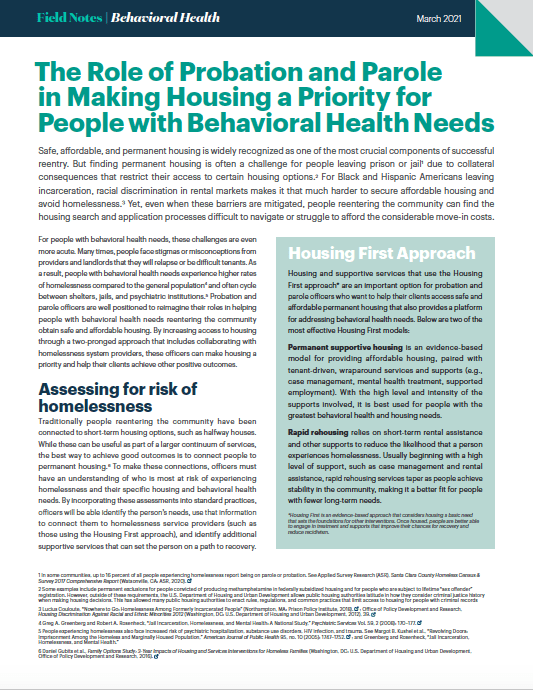The Role of Probation and Parole in Making Housing a Priority for People with Behavioral Health Needs
The Role of Probation and Parole in Making Housing a Priority for People with Behavioral Health Needs
Safe, affordable, and permanent housing is widely recognized as one of the most crucial components of successful reentry. But finding permanent housing is often a challenge for people leaving prison or jail, particularly people with behavioral health needs who experience higher rates of homelessness compared to the general population and often cycle between shelters, jails, and psychiatric institutions. Parole and probation officers are well positioned to help people with behavioral health needs obtain safe and affordable housing as they reenter the community. But these officers cannot do it alone; by collaborating with homelessness system providers, they can help their clients achieve positive outcomes and make housing a reentry priority. Photo by Martyna Bober on Unsplash.
Safe, affordable, and permanent housing is widely recognized as one of the most crucial components of successful reentry. But finding permanent housing is often a challenge for people leaving prison or jail1 due to collateral consequences that restrict their access to certain housing options.2 For Black and Hispanic Americans leaving incarceration, racial discrimination in rental markets makes it that much harder to secure affordable housing and avoid homelessness.3 Yet, even when these barriers are mitigated, people reentering the community can find the housing search and application processes difficult to navigate or struggle to afford the considerable move-in costs.
For people with behavioral health needs, these challenges are even more acute. Many times, people face stigmas or misconceptions from providers and landlords that they will relapse or be difficult tenants. As a result, people with behavioral health needs experience higher rates of homelessness compared to the general population4 and often cycle between shelters, jails, and psychiatric institutions.5
Probation and parole officers are well-positioned to reimagine their roles in helping people with behavioral health needs reentering the community obtain safe and affordable housing. By increasing access to housing through a two-pronged approach that includes collaborating with homelessness system providers, these officers can make housing a priority and help their clients achieve other positive outcomes.
Housing First Approach
Housing and supportive services that use the Housing First approach* are an important option for probation and parole officers who want to help their clients access safe and affordable permanent housing that also provides a platform for addressing behavioral health needs. Below are two of the most effective Housing First models:
Permanent supportive housing is an evidence-based model for providing affordable housing, paired with tenant-driven, wraparound services and supports (e.g., case management, mental health treatment, supported employment). With the high level and intensity of the supports involved, it is best used for people with the greatest behavioral health and housing needs.
Rapid rehousing relies on short-term rental assistance and other supports to reduce the likelihood that a person experiences homelessness. Usually beginning with a high level of support, such as case management and rental assistance, rapid rehousing services taper as people achieve stability in the community, making it a better fit for people with fewer long-term needs.
*Housing First is an evidence-based approach that considers housing a basic need that sets the foundations for other interventions. Once housed, people are better able to engage in treatment and supports that improve their chances for recovery and reduce recidivism.
Assessing for risk of homelessness
Traditionally people reentering the community have been connected to short-term housing options, such as halfway houses. While these can be useful as part of a larger continuum of services, the best way to achieve good outcomes is to connect people to permanent housing.6
To make these connections, officers must have an understanding of who is most at risk of experiencing homelessness and their specific housing and behavioral health needs. By incorporating these assessments into standard practices, officers will be able to identify the person’s needs, use that information to connect them to homelessness service providers (such as those using the Housing First approach), and identify additional supportive services that can set the person on a path to recovery.
When seeking out and implementing effective homelessness risk assessments, the following should be considered:
- Conduct homelessness risk assessments as part of overall screenings when someone begins probation or parole (prior to diversion or release from incarceration).
- Evaluate homelessness assessment tools and referral data for racial and ethnic biases.
- Keep the assessment simple and work with people to complete it, including provisions for anyone with reading comprehension concerns; also use common language about housing that all partners can understand.
- Incorporate a definition for homelessness that accounts for factors not considered in the federal definition,7 such as long periods of incarceration or housing instability.
- Ensure the assessment addresses the following: (1) previous experiences of homelessness; (2) ability to afford housing; (3) previous incidents or convictions that might restrict someone from residing in public or subsidized housing; (4) housing that may have been interrupted due to incarceration; (5) cultural and linguistic preferences; (6) recognition of any intellectual and developmental disabilities or physical disabilities; and (7) individualized housing services, such as for veterans, people living with HIV, or young adults who are transitioning from foster care.
- Keep the client’s choices and assessed needs in mind when making referrals to avoid placing people in mismatched programs that do not set them up for success.
Connecting with homelessness service providers and landlords
With high competition for affordable permanent housing, probation and parole departments will need to partner with service providers and landlords to ensure their clients with behavioral health needs are prioritized as best possible. The following steps can be used to establish or maintain these partnerships:
- Join the local Continuum of Care, the regional planning body that coordinates local responses to homelessness and connections to housing resources, to better understand the Coordinated Entry process for assessing and referring people to homelessness services and to advocate for prioritizing client’s needs.
- Speak with the local public housing authority to understand any current criminal record restrictions.
- Reach out to landlords or landlord associations to educate them about reducing stigma, setting realistic expectations around the risks of recidivism and relapse, and to encourage them to rent to people on supervision.
- Recruit homelessness service providers and landlords who reflect the diversity and demographics of the community into collaborative case management teams to better respond to housing and behavioral health needs and mitigate biases in securing permanent housing.
- Use these case management teams to identify any housing challenges, problem-solving for rules that might prevent someone from keeping their housing such as landlord stipulations around pets or visitors.
Once their clients are in permanent housing, officers can continue to collaborate with providers and their case management team to ensure people’s success by helping to prevent revocations or rearrests.
Dig Deeper
If you are interested in additional support for making housing a priority for people with behavioral health needs as they prepare for reentry, visit the Center for Justice and Mental Health Partnerships. The center offers free training, resources, and specialized support to communities wanting to improve outcomes or enhance current responses for people in their criminal justice systems who have a mental illness or co-occurring substance use disorder.
Additional Resources
Assessing Housing Needs and Risks: A Screening Questionnaire helps reentry professionals better assess an individual’s unique housing needs and risk of homelessness.
Reducing Homelessness for People with Behavioral Health Needs Leaving Prison and Jail is a state-level analysis that highlights 5 areas where this population in California experiences the greatest challenges in accessing housing and provides 10 recommendations for leaders to take action.
Footnotes
1In some communities, up to 16 percent of all people experiencing homelessness report being on parole or probation. See Applied Survey Research (ASR), Santa Clara County Homeless Census &Survey 2017 Comprehensive Report (Watsonville, CA: ASR, 2020).
2Some examples include permanent exclusions for people convicted of producing methamphetamine in federally subsidized housing and for people who are subject to lifetime “sex offender” registration. However, outside of these requirements, the U.S. Department of Housing and Urban Development allows public housing authorities latitude in how they consider criminal justice history when making housing decisions. This has allowed many public housing authorities to enact rules, regulations, and common practices that limit access to housing for people with criminal records
3Lucius Couloute, “Nowhere to Go: Homelessness Among Formerly Incarcerated People” (Northampton, MA: Prison Policy Institute, 2018). ; Office of Policy Development and Research, Housing Discrimination Against Racial and Ethnic Minorities 2012 (Washington, DC: U.S. Department of Housing and Urban Development, 2012), 39.
5People experiencing homelessness also face increased risk of psychiatric hospitalization, substance use disorders, HIV infection, and trauma. See Margot B. Kushel et al., “Revolving Doors: Imprisonment Among the Homeless and Marginally Housed Population,” American Journal of Public Health 95, no. 10 (2005): 1747–1752. ; and Greenberg and Rosenheck, “Jail Incarceration, Homelessness, and Mental Health.”
7In 2015, the U.S. Department and Housing and Urban Development’s issued a “final rule” establishing the definition of chronic homelessness. It excludes people from services available under this definition if an individual has been in an institution, such as prison or jail, for 90 or more days in a year. See 24 CFR Parts 91 and 578 RIN 2506-AC37.
Project Credits
Writing: Thomas Coyne, CSG Justice Center
Research: Thomas Coyne, CSG Justice Center
Advising: Charles Francis, Alex Blandford, and Demetrius Thomas, CSG Justice Center
Editing: Darby Baham, Emily Morgan, CSG Justice Center
Design: Michael Bierman
Public Affairs: Ruvi Lopez, CSG Justice Center
ABOUT THE AUTHOR
The sharp rise in school shootings over the past 25 years has led school officials across the U.S.…
Read MoreA three-digit crisis line, 988, launched two years ago to supplement—not necessarily replace—911. Calling 988 simplifies access to…
Read MoreIt would hardly be controversial to expect an ambulance to arrive if someone called 911 for a physical…
Read More Taking the HEAT Out of Campus Crises: A Proactive Approach to College Safety
Taking the HEAT Out of Campus Crises: A Proactive Approach to College Safety
The sharp rise in school shootings over the past 25 years has…
Read More From 911 to 988: Salt Lake City’s Innovative Dispatch Diversion Program Gives More Crisis Options
From 911 to 988: Salt Lake City’s Innovative Dispatch Diversion Program Gives More Crisis Options
A three-digit crisis line, 988, launched two years ago to supplement—not necessarily…
Read More Matching Care to Need: 5 Facts on How to Improve Behavioral Health Crisis Response
Matching Care to Need: 5 Facts on How to Improve Behavioral Health Crisis Response
It would hardly be controversial to expect an ambulance to arrive if…
Read More











